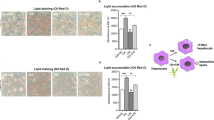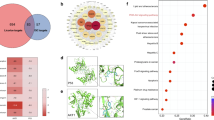Abstract
Objective
Cymbopogon citratus (DC.) Stapf is a medicinal and edible herb that is widely used for the treatment of gastric, nervous and hypertensive disorders. In this study, we investigated the cardioprotective effects and mechanisms of the essential oil, the main active ingredient of Cymbopogon citratus, on isoproterenol (ISO)-induced cardiomyocyte hypertrophy.
Methods
The compositions of Cymbopogon citratus essential oil (CCEO) were determined by gas chromatography-mass spectrometry. Cardiomyocytes were pretreated with 16.9 µg/L CCEO for 1 h followed by 10 µmol/L ISO for 24 h. Cardiac hypertrophy-related indicators and NLRP3 inflammasome expression were evaluated. Subsequently, transcriptome sequencing (RNA-seq) and target verification were used to further explore the underlying mechanism.
Results
Our results showed that the CCEO mainly included citronellal (45.66%), geraniol (23.32%), and citronellol (10.37%). CCEO inhibited ISO-induced increases in cell surface area and protein content, as well as the upregulation of fetal gene expression. Moreover, CCEO inhibited ISO-induced NLRP3 inflammasome expression, as evidenced by decreased lactate dehydrogenase content and downregulated mRNA levels of NLRP3, ASC, CASP1, GSDMD, and IL-1β, as well as reduced protein levels of NLRP3, ASC, pro-caspase-1, caspase-1 (p20), GSDMD-FL, GSDMD-N, and pro-IL-1β. The RNA-seq results showed that CCEO inhibited the increase in the mRNA levels of 26 oxidative phosphorylation complex subunits in ISO-treated cardiomyocytes. Our further experiments confirmed that CCEO suppressed ISO-induced upregulation of mt-Nd1, Sdhd, mt-Cytb, Uqcrq, and mt-Atp6 but had no obvious effects on mt-Col expression.
Conclusion
CCEO inhibits ISO-induced cardiomyocyte hypertrophy through the suppression of NLRP3 inflammasome expression and the regulation of several oxidative phosphorylation complex subunits.
Similar content being viewed by others
References
Yang J, Chen Y, Li X, et al. New insights into the roles of glucocorticoid signaling dysregulation in pathological cardiac hypertrophy. Heart Fail Rev, 2022,27(4):1431–1441
Caturano A, Vetrano E, Galiero R, et al. Cardiac Hypertrophy: From Pathophysiological Mechanisms to Heart Failure Development. Rev Cardiovasc Med, 2022,23(5):165
Chai R, Xue W, Shi S, et al. Cardiac Remodeling in Heart Failure: Role of Pyroptosis and Its Therapeutic Implications. Front Cardiovasc Med, 2022,9:870924
Haque ANMA, Remadevi R, Naebe M. Lemongrass (Cymbopogon): a review on its structure, properties, applications and recent developments. Cellulose, 2018,25:5455–5477
Ekpenyong CE, Akpan E, Nyoh A. Ethnopharmacology, phytochemistry, and biological activities of Cymbopogon citratus (DC.) Stapf extracts. Chin J Nat Med, 2015,13(5):321–337
Salaria D, Rolta R, Sharma N, et al. In vitro and in silico antioxidant and anti-inflammatory potential of essential oil of Cymbopogon citratus (DC.) Stapf. of North-Western Himalaya. J Biomol Struct Dyn, 2022,40(24):14131–14145
Li C, Luo Y, Zhang W, et al. A comparative study on chemical compositions and biological activities of four essential oils: Cymbopogon citratus (DC.) Stapf, Cinnamomum cassia (L.) Presl, Salvia japonica Thunb. and Rosa rugosa Thunb. J Ethnopharmacol, 2021,280:114472
Lu JX, Qiu Y, Guo LJ, et al. Potential Therapeutic Effect of Citronellal on Diabetic Cardiomyopathy in Experimental Rats. Evid Based Complement Alternat Med, 2021,2021:9987531
Liu X, Qiu Y, Huang N, et al. Citronellal alleviates doxorubicin-induced cardiotoxicity by suppressing oxidative stress and apoptosis via Na+/H+ exchanger-1 inhibition. J Biochem Mol Toxicol, 2022,36(3):e22971
Rhana P, Barros GM, Santos VCO, et al. S-limonene protects the heart in an experimental model of myocardial infarction induced by isoproterenol: Possible involvement of mitochondrial reactive oxygen species. Eur J Pharmacol, 2022,930:175134
Li H, Qiu Y, Xie M, et al. Momordicine I alleviates isoproterenol-induced cardiomyocyte hypertrophy through suppression of PLA2G6 and DGK-ζ. Korean J Physiol Pharmacol, 2023,27(1):75–84
Bastos JF, Moreira IJ, Ribeiro TP, et al. Hypotensive and vasorelaxant effects of citronellol, a monoterpene alcohol, in rats. Basic Clin Pharmacol Toxicol, 2010,106(4):331–337
Zou G, Wan J, Balupillai A, et al. Geraniol enhances peroxiredoxin-1, and prevents isoproterenol-induced oxidative stress and inflammation associated with myocardial infarction in experimental animal models. J Biochem Mol Toxicol, 2022,36(8):e23098
Bai C, Ma Q, Li Q, et al. Combination of 1,8-cineole and beta-caryophyllene synergistically reverses cardiac hypertrophy in isoprenaline-induced mice and H9c2 cells. Bioorg Chem, 2022,124:105823
Althurwi HN, Abdel-Kader MS, Alharthy KM, et al. Cymbopogon Proximus Essential Oil Protects Rats against Isoproterenol-Induced Cardiac Hypertrophy and Fibrosis. Molecules, 2020,25(8):1786
Liao Y, Liu K, Zhu L. Emerging Roles of Inflammasomes in Cardiovascular Diseases. Front Immunol, 2022,13:834289
Zhao M, Zhang J, Xu Y, et al. Selective Inhibition of NLRP3 Inflammasome Reverses Pressure Overload-Induced Pathological Cardiac Remodeling by Attenuating Hypertrophy, Fibrosis, and Inflammation. Int Immunopharmacol, 2021,99:108046
Shi Y, Zhao L, Wang J, et al. The selective NLRP3 inflammasome inhibitor MCC950 improves isoproterenol-induced cardiac dysfunction by inhibiting cardiomyocyte senescence. Eur J Pharmacol, 2022,937:175364
Xin JZ, Wu JM, Hu GM, et al. α1-AR overactivation induces cardiac inflammation through NLRP3 inflammasome activation. Acta Pharmacol Sin, 2020,41(3):311–318
Yue R, Zheng Z, Luo Y, et al. NLRP3-mediated pyroptosis aggravates pressure overload-induced cardiac hypertrophy, fibrosis, and dysfunction in mice: cardioprotective role of irisin. Cell Death Discov, 2021,7(1):50
Xu Z, Zhou X, Hong X, et al. Essential oil of Acorus tatarinowii Schott inhibits neuroinflammation by suppressing NLRP3 inflammasome activation in 3 × Tg-AD transgenic mice. Phytomedicine, 2023,112:154695
Chen P, Bai Q, Wu Y, et al. The Essential Oil of Artemisia argyi H.Lév. and Vaniot Attenuates NLRP3 Inflammasome Activation in THP-1 Cells. Front Pharmacol, 2021,12:712907
Dou X, Yan D, Liu S, et al. Thymol Alleviates LPS-Induced Liver Inflammation and Apoptosis by Inhibiting NLRP3 Inflammasome Activation and the AMPK-mTOR-Autophagy Pathway. Nutrients, 2022,14(14):2809
Yang Q, Liu Q, Lv H, et al. Effect of pulegone on the NLPR3 inflammasome during inflammatory activation of THP-1 cells. Exp Ther Med, 2020,19(2):1304–1312
Wang K, Chen D, Yu B, et al. Eugenol Alleviates TGEV-Induced Intestinal Injury via Suppressing ROS/NLRP3/GSDMD-Dependent Pyroptosis. J Agric Food Chem, 2023,71(3):1477–1487
Sokolova M, Ranheim T, Louwe MC, et al. NLRP3 Inflammasome: A Novel Player in Metabolically Induced Inflammation-Potential Influence on the Myocardium. J Cardiovasc Pharmacol, 2019,74(4):276–284
Meyers AK, Zhu X. The NLRP3 Inflammasome: Metabolic Regulation and Contribution to Inflammaging. Cells, 2020,9(8):1808
Liang JJ, Fraser IDC, Bryant CE. Lipid regulation of NLRP3 inflammasome activity through organelle stress. Trends Immunol, 2021,42(9):807–823
Zhao RZ, Jiang S, Zhang L, et al. Mitochondrial electron transport chain, ROS generation and uncoupling (Review). Int J Mol Med, 2019,44(1):3–15
Cheng J, Nanayakkara G, Shao Y, et al. Mitochondrial Proton Leak Plays a Critical Role in Pathogenesis of Cardiovascular Diseases. Adv Exp Med Biol, 2017,982:359–370
Author information
Authors and Affiliations
Corresponding authors
Ethics declarations
The authors declare that there is no conflict of interest with any financial organization or corporation or individual that can inappropriately influence this work.
Additional information
This work was supported by grants from the National Natural Science Foundation of China (Nos. 81960732 and 82060733), the Natural Science Foundation of Jiangxi Province (No. 20224BAB206111), the Science and Technology Plan of Jiangxi Provincial Health Commission (No. 202311141), the Open Project of Jiangxi Provincial Key Laboratory of Drug Design and Evaluation (No. JKLDE-KF-2101), and the Open Project of Key Laboratory of Modern Preparation of TCM, Ministry of Education, Jiangxi University of Chinese Medicine (No. TCM-201911).
Rights and permissions
About this article
Cite this article
Ding, Xy., Zhang, H., Qiu, Ym. et al. Cardioprotective Potential of Cymbopogon citratus Essential Oil against Isoproterenol-induced Cardiomyocyte Hypertrophy: Possible Involvement of NLRP3 Inflammasome and Oxidative Phosphorylation Complex Subunits. CURR MED SCI 44, 450–461 (2024). https://doi.org/10.1007/s11596-024-2851-9
Received:
Accepted:
Published:
Issue Date:
DOI: https://doi.org/10.1007/s11596-024-2851-9




